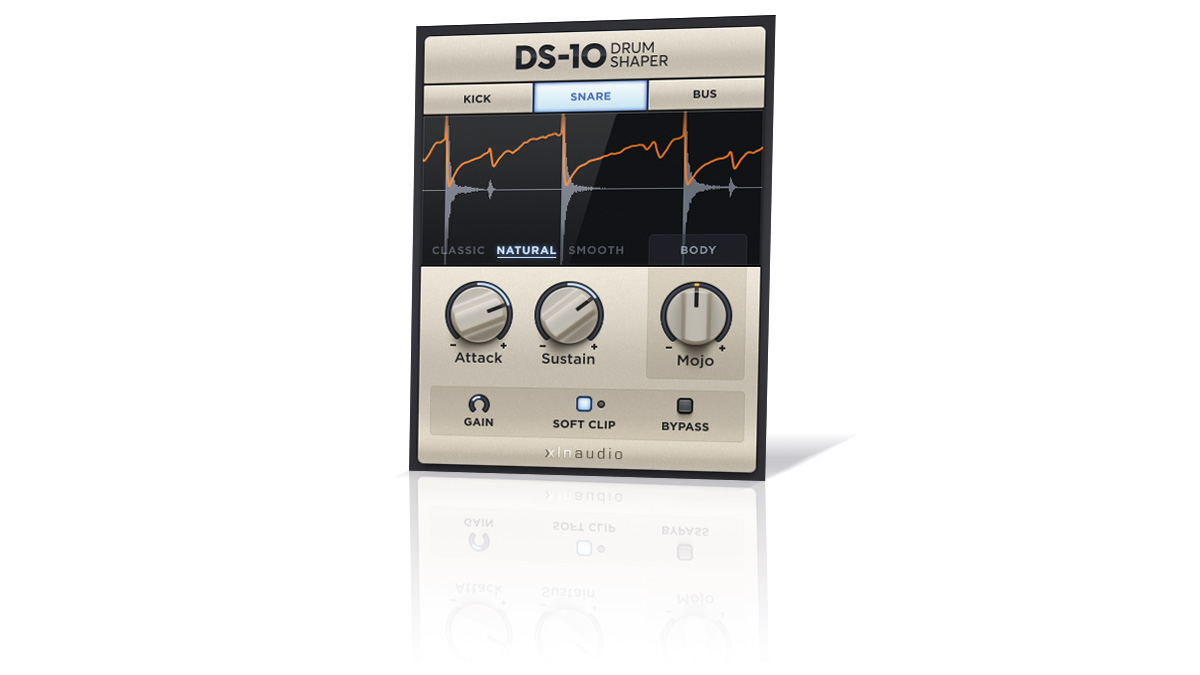MusicRadar Verdict
DS-10 brings drum-specific transient shaping to your DAW, cleanly, simply and with excellent results.
Pros
- +
For Classic mode adds color. Powerful Natural & Smooth algorithms. Mojo feature for further shaping. Real-time waveform and tracer display. Optional output clipper.
Cons
- -
No input gain. No multi band option.
MusicRadar's got your back
XLN Audio is best known for its Addictive series of sample-based drum and keyboard instruments, and one often-overlooked aspect of these packages is their excellent onboard effects processing.
DS-10 Drum Shaper (VST/AU/AAX) is the first Addictive FX, a transient shaper that combines three drum-specific Modes (Kick, Snare and Bus) with a trio of shaping algorithms (Classic, Natural and Smooth).
The Mode is selected using the three buttons at the top, and the detection and applied gain curve are optimised for the named drum type. Bus is the most general-purpose option, working well with stereo drum mixes, while Snare and Kick are tailored to the frequency content and characteristic transient nature of those drums.
The three algorithms influence the overall decay style, with Classic (the same as Addictive Drums 2's Shape processor) being quite aggressive and 'pumping', Natural more refined, and Smooth having the smoothest decay of all.
Transient lengthening and shortening is done via typical Attack and Sustain controls (+/-100% for each), and further enhancement is provided by the Mojo control, which affects a particular 'quality' depending on the Mode: Tightness in Kick Mode, Body in Snare Mode and Presence in Bus Mode. After this you get output Gain, followed by Soft Clip and Bypass buttons.
DS-10 also features a real-time input signal waveform display with an orange envelope trace indicating the gain applied by the transient shaper.
The shape of things to drum
The choice of algorithm has a more obvious impact on transient shaping than the Mode setting. Classic is by far the most coloured of the three; positive Sustain settings really emphasise tails of snares in that mode, for example.
In contrast, thanks to its fast attack and initial post- transient release, the Natural algorithm is very transparent, enabling more careful emphasis of the tail with the Sustain control. Smooth shares the same fast response, but with a slightly gentler initial sustain.
One more consideration is that more transient gain is applied with the Natural and Smooth algorithms than Classic. The upshot of all of this is that the Natural and, to some extent, Smooth options deliver cleaner, punchier, louder transients than Classic, and this is most noticeable with kick drums, where Classic sounds positively lacklustre in comparison.
The Mojo knob introduces another layer of frequency-specific shaping that dovetails nicely with Attack and Sustain, and its tighter settings are brilliantly effective on kicks and snares, counteracting some of the frequency build-up that results from really long Sustain settings.
In Bus Mode, meanwhile, Mojo (Presence) works well as an enhancer or harshness tamer on overheads, and we even had some success applying it to full-frequency sounds such as acoustic guitar, piano and electric bass.
Our only minor issues with DS-10 are the lack of input gain, simply to help with gain staging, and multiband operation (especially for Bus mode), which could be useful. Ultimately though, DS-10 is a very useful plugin, offering more targeted and effective tools for drum shaping than your typical transient shaper.
Computer Music magazine is the world’s best selling publication dedicated solely to making great music with your Mac or PC computer. Each issue it brings its lucky readers the best in cutting-edge tutorials, need-to-know, expert software reviews and even all the tools you actually need to make great music today, courtesy of our legendary CM Plugin Suite.
"There’s plenty for us guitarists to learn – and ‘less is more’ is the overriding lesson": how to play like George Harrison on The Beatles' Abbey Road
“They didn’t like Prince’s bikini underwear”: Prince’s support sets for the The Rolling Stones in 1981 are remembered as disastrous, but guitarist Dez Dickerson says that the the crowd reaction wasn’t as bad as people think
“We are so unencumbered and unbothered by these externally imposed rules or other people’s ideas for what music should be”: Blood Incantation on the making of Absolute Elsewhere and how “Data from Star Trek” saved the album – and the studio











